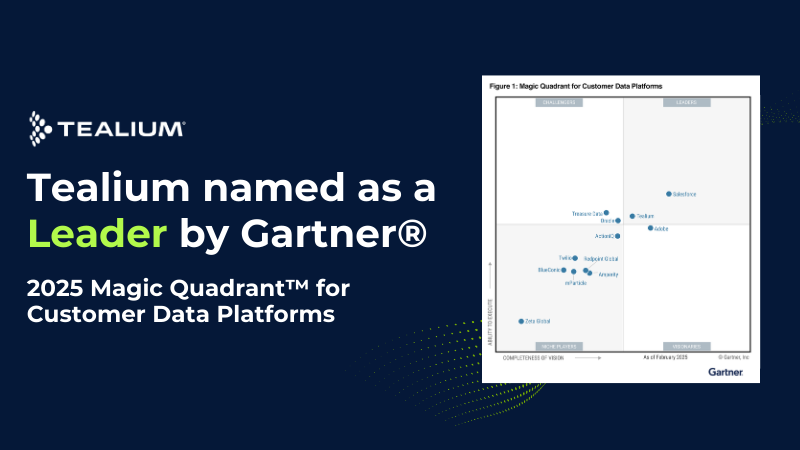FIRST THINGS FIRST: WHAT IS A TAG?
A tag, sometimes called a pixel, is a piece of JavaScript code that most Martech vendors require users to integrate into their web and mobile sites to perform a task such as advertising, live chat, and product recommendations. In addition to supporting your digital marketing efforts, these ‘tags’ collect unique visitor behavior information.
WHAT IS TAG MANAGEMENT?
A tag management system (TMS) makes it simple for users to implement, manage, and maintain tags on their digital properties with an easy to use web interface. Using a TMS is integral to providing a foundation for your organization’s data collection and governance needs while helping to drive better customer experiences.
What Tag Management is NOT
Tag management is not the most exciting name for a crucial technology, often being confused with blog tags, tag clouds or search engine meta tags. Tag management is not related to any of those. Tags are a means to collect and move data between a website or mobile app session, and the technology vendor. Nevertheless, that is how the industry evolved, and the name stuck, although it is quickly becoming part of a larger data conversation.

The Rise of Tag Management
Tag management systems emerged in the late 2000s to address challenges posed by the explosive growth in digital marketing solutions, now exceeding 8,000, according to ChiefMartec.com, a leading authority on marketing technology. Tag management helps organizations strategically manage their data foundation and streamline tag deployments, which previously required ongoing IT assistance to support.
The Perfect Storm of Martech Growth
“The explosion of marketing technologies is the perfect storm of three things. First, marketers have an incredibly diverse set of needs and desires in their digital marketing programs. Second, marketing technology vendors are doing a tremendous job of innovating solutions that address those needs and desires and inspire new possibilities. And third, the advancement of marketing technology platforms and middleware — including tag management — is making it easier for marketers to put these pieces together in a cohesive marketing stack, tailored to their business.”
— Scott Brinker, ChiefMartec.com
Tag Management Extends Beyond the Website
Tag management has moved rapidly to help manage tags and data outside of the traditional website. Companies are using tag management to control and manage their customer data and MarTech vendors across web, mobile, IoT, and connected devices. One thing to note about mobile apps is that instead of using a master tag from the tag management provider, they leverage a library that serves the same essential purpose. Once the library is added to the mobile app, marketers and mobile developers can add analytics and other solutions without having to recertify the app in the mobile app marketplaces.

How Tag Management Systems Work
Tag management systems control the deployment of all other tags and mobile vendor deployments via an intuitive web interface, without requiring any software coding. Tag management systems make it easy to add, edit or remove any tag with point and click simplicity. Enterprise tag management solutions – compared to free tag managers – also deliver a variety of advanced capabilities, such as customization, data management, privacy controls, mobile application support and much more.

Key Benefits of Tag Management
5 Key Benefits of Tag Management
- Build and manage your own best-in-class marketing stack – Create a data collection foundation that works with 1300+ technology solutions allowing you to quickly and easily swap out old solutions and test new ones
- Accelerate campaign time to market – Marketers can launch more revenue-generating campaigns faster and easier.
- Improve website performance – Intelligent tag loading and superior architecture ensure your site loads fast.
- Reduce costs and focus on business – Free up valuable marketing and IT resources for strategic projects.
- Ensure Data Governance and Protection – Audit and control the data collection practices of each of your vendors, while also standardizing data definitions across solutions.
WHY SHOULD YOU CARE? FIRST PARTY DATA.
Because of its strategic position in the data supply chain, tag management systems have rapidly evolved to become a key part of the foundation for data management and collection. A tag management system collects first party data. First party data is considered the most powerful and relevant data because it is the behaviors and interactions you compile on visitors. This robust first party data can be used to create unified customer profiles, driving more timely and relevant omnichannel experiences while fueling business intelligence initiatives and streamlining data warehouse projects.
REASONS YOU NEED A TAG MANAGEMENT SOLUTION
There are many factors in determining whether you need tag management. Here are six sure-fire signs…
- You are actively using more than five digital marketing solutions
- You are using a complex, enterprise analytics solution, such as Adobe Analytics or IBM Coremetrics
- You are about to expand your acquisition or performance marketing activities, i.e., launching new campaigns and attribution tracking
- You are about to deploy mobile apps – the same benefits that tag management provides for traditional sites, also apply to mobile apps
- You are about to redesign your website– maintaining analytics and campaign continuity is crucial
- You want the flexibility to change marketing vendors
Take a self-guided tour of Tealium iQ Tag Management








